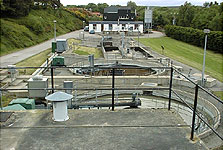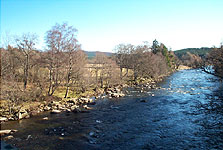A vast network of pipes and pumping stations transports sewage to wastewater treatment works (WwTW) for treatment. A Consent issued by SEPA states the location of discharge, flow rate and concentrations of chemical determinants, usually biochemical oxygen demand, total suspended solids, ammonia and phosphate, that the final effluent must comply with prior to discharge. The Consent conditions ensure that the receiving environment can absorb the discharge without ill effect and the design and operating conditions of the works ensures compliance with this Consent.
WwTWs vary in size and complexity according to the catchment they serve but the basic processes remain the same.
During preliminary treatment sewage is screened to remove larger items of debris then passed through channels or tanks designed to remove inorganic grit and sand. This waste material is removed and sent to approved land fill sites or burnt in incinerators.
Primary treatment allows the process of sedimentation; the sewage is retained in tanks for a period of time so that suspended solid matter can settle to the bottom and form into sludge. The sludge is removed for further treatment or recycling and the supernatant, now referred to as Settled Sewage (SS), is transferred on through the works.
Secondary or biological treatment is usually carried out by one of two processes, both of which use naturally occurring micro-organisms to break down organic material. In Biological Filtration the SS is sprayed from a moving distributor arm onto a deep bed of small stones or plastic media known as a percolating filter. This medium provides an environment where bacteria, and the organisms which in turn feed on them, can grow and as the SS trickles down the water is purified. A Reed Bed may be added to further polish the effluent and remove nutrients before discharge.
The main alternative is to use the Activated Sludge (AS) method. The AS, which contains specialist bacteria, is mixed together with the SS in a tank. Air is introduced into the liquid by vigorous mixing or aeration to supply the bacteria with sufficient oxygen to break down the organic material during respiration. Extended periods of aeration or an anoxic zone can be incorporated into the works to ensure sufficient purification where a high quality effluent is required.
Final treatment is carried out in humus tanks where any suspended material from the previous treatment stage can settle out. The final effluent is now clean enough to be returned to the environment.
Select this link to see the locations of Deeside’s 16 WwTWs.
Select this link for Scottish Water information about the wastewater treatment process.





